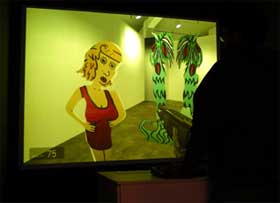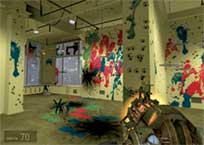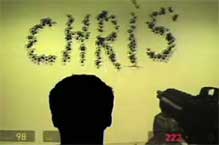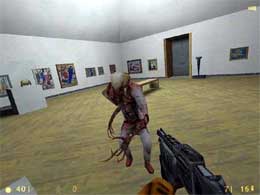 Everything I Do is Art, But Nothing I Do Makes Any Difference is a playable level for Half Life 2 and a performance conceived as a direct response to an installation of his friend Pat Rios.
Everything I Do is Art, But Nothing I Do Makes Any Difference is a playable level for Half Life 2 and a performance conceived as a direct response to an installation of his friend Pat Rios.
Rios had filled a Chicago gallery with objects and furniture that suggested his mantra that ‘everything he does is art.’ Chris Reilly replicated the gallery space and its art pieces in a 3D first person shooter game environment by manipulating its architecture. During the performance, Reilly manipulated the character to “interactâ€? with the space. Shooting up the room, blowing up Pat Rios’ installation, and graffitiing “CHRISâ€? on the wall with a machine gun. Reilly was not only paying homage to male adolescents impulses within gaming environments, but also reacting to Rios’ artistic vision.
“After all, if everything you do is art, that’s kind of like saying nothing you do is art; everything’s on the same level,” explained Reilly. “That condition goes along well with a video game, where everything is basically without consequence. If you die, just start over and everything’s back to the way it was.”


In a second version of the work, Everything I Do is Art, But Nothing I Do Makes Any Difference, Part II Or: How I Learned to Stop Worrying and Love the Gallery, the 3 floors of an art gallery had been modeled, along with some of the artworks from the show.
The Ai systems of the modified Source engine was unleashing attacks of monsters, aliens, robots and zombies (all of them characters from the original game) on unwitting virtual gallery attendants. Health points and extra ammo could be earned by machine-gunning the artwork. Players/performers were also given a vast arsenal of military-grade guns for “expressive destruction” of the gallery walls. They could also pick up cans of spray paint to create their own art works.
The performance reminded me of Ars Doom that Orhan Kipcak and Reinhard Urban developed for the 1995 edition of Ars Electronica as a satire on the art business.
 Using the Doom engine the artists reproduced in 3D the exhibition space. Equipped with their tools—Georg Baselitz’ thumbs, Nam June Paik’s remote control or Arnulf Rainer’s paint brush— the visitor (at the exhibition center or online anywhere in the world) could destroy works of art, other artists and art critics. The favourite victim of players was said to have been exhibition director Peter Weibel.
Using the Doom engine the artists reproduced in 3D the exhibition space. Equipped with their tools—Georg Baselitz’ thumbs, Nam June Paik’s remote control or Arnulf Rainer’s paint brush— the visitor (at the exhibition center or online anywhere in the world) could destroy works of art, other artists and art critics. The favourite victim of players was said to have been exhibition director Peter Weibel.
The work is also said to be the first attempt by an artist to use a computer game as an artistic medium. Other similar game mods followed such as Museum Meltdown (image on the right), by Palle Torsson and Tobias Bernstrup, another first person shooter game mod that allowed museum visitors to wander around a virtual version of the exhibition space killing people and blowing up masterpieces.
Julian also points to Stephen Honegger and Anthony Hunt’s Container.
Via the always excellent Videoludica.
Check also Maia Engeli‘s list of Art Game Mods of a Shooter Game; exibart’s story on videogames vs musei (english version), inspired by this page from Media Art Net.
Front‘s “Representation of Things” that uses computer game as a design tool.
